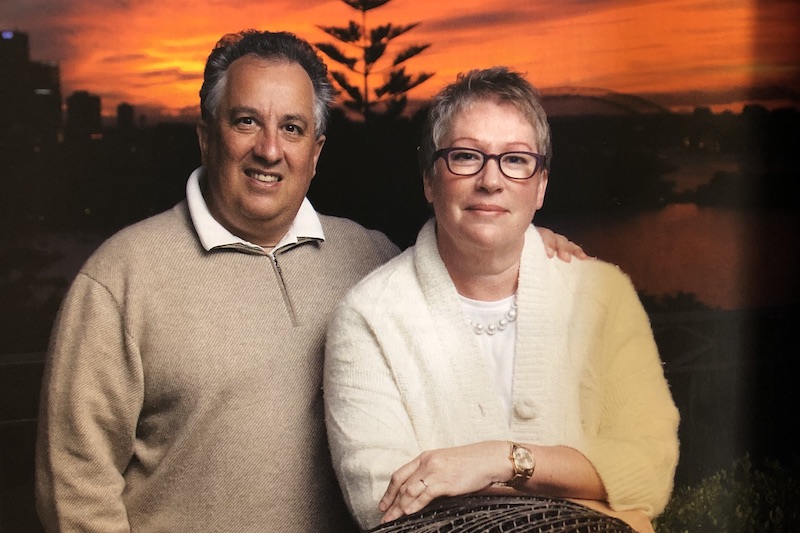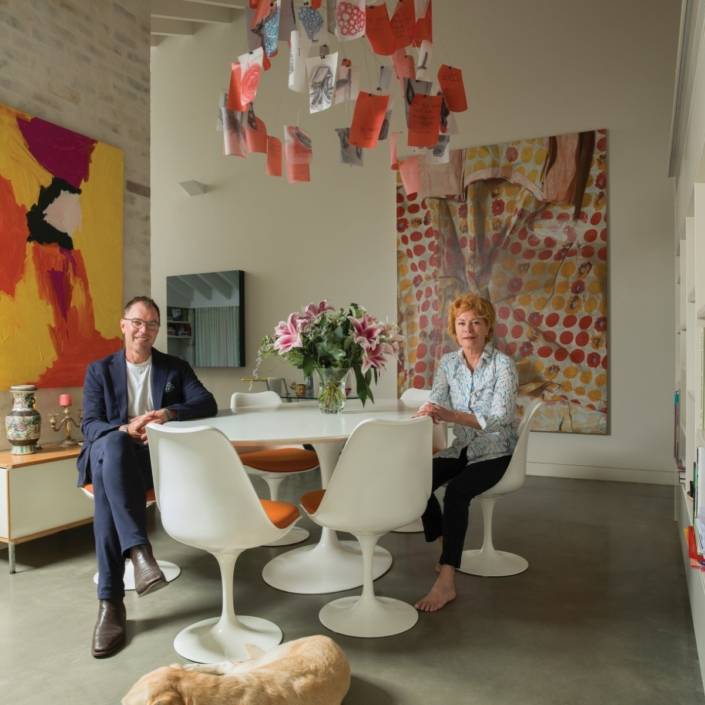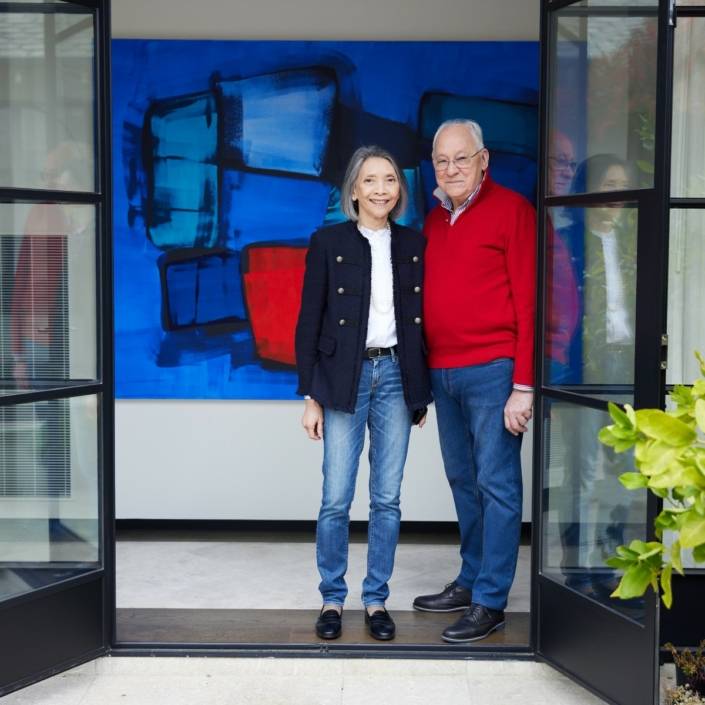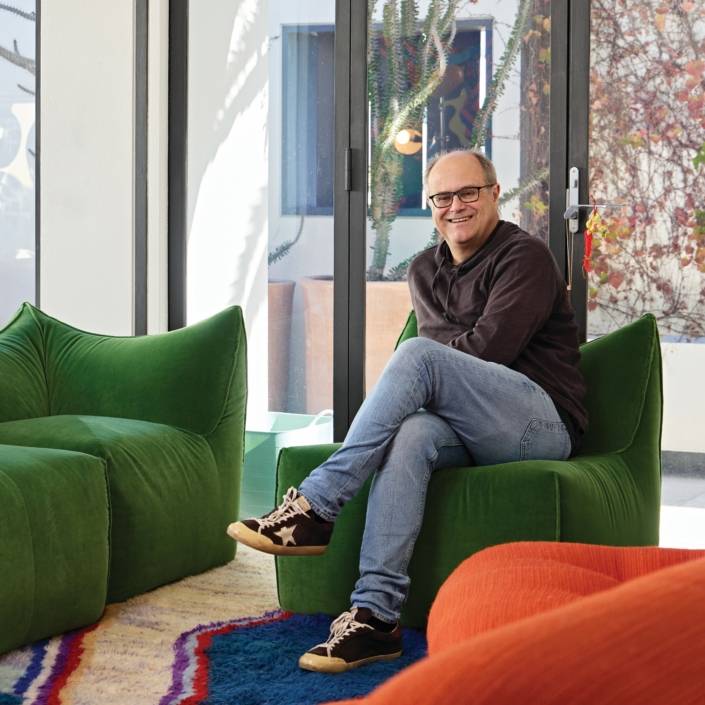Simon and Catriona Mordant: Fortune and Philanthropy
Even though their wealth was built in investment banking, Simon and Catriona Mordant haven’t ever brought the tenets of high finance into their decisions about art purchases. The tell tale sign is the fact that they have never sold a single piece of art.
Words: Carrie Miller
The most striking thing you notice visiting the home of high-profile philanthropists and art collectors Simon and Catriona Mordant – besides the beautifully visceral Dale Frank painting in the entrance hall and the breathtaking panorama of Sydney Harbour from their balcony – is how refreshingly down-to-earth they are.
The first clue about the Mordants as people, and what motivates them as collectors, comes when they give me a casual tour of their apartment – a modest place by the standards of their harbourside neighbourhood.
Despite the beautiful view, they are a couple completely devoid of ostentation. When Catriona admires a jacket I’m wearing and I reveal the $25 price tag, she tells me she’s not bothered by designer labels either. The equally inexpensive t-shirt she’s wearing this afternoon confirms this – it definitely doesn’t carry the brand name typically favoured by female subjects of glossy magazine photo shoots.
And while they own many impressive pieces – including an iconic Bronwyn Oliver sculpture on the terrace – the couple’s home is no sterile, pretentious art museum. Simply put, the Mordants don’t live with their art; their art lives with them. The art objects aren’t elevated, given a reverential status beyond anything else in the house. They are part of the furniture, part of the everyday lives of the family that lives amongst them.
It’s probably a misnomer to call them “collectors” in the formal sense at all – they’re passionate art lovers who, as they say, happen to be “fortunate” enough to be able to fund their joint obsession. That fortune comes from the success of Simon’s investment banking career as co-founder and joint Managing Director of Caliburn Patnership.
The Mordants have been collecting together since marrying twenty years ago, but their love of art pre-dates the relationship. While Catriona came from a more “arty” background, including professional work in theatrical costume design, Simon’s family “had no interest in the arts at all”.
As a teenager, Simon took himself off to the museums in London where he grew up and at the Royal Academy Summer Show not only acquired his first work at 14, but precociously began a correspondence with the artist. Establishing such a personal connection has been a continuing theme for the couple as art collectors ever since. As Simon puts it: “We’ve tried to get to know the artists and understand the works, and many of the artists have become good friends of ours.”
It’s an open secret in the art world that when such direct relationships are established between artists and collectors, the dealer is often cut out of the acquisition process and work gets bought out of the studio backdoor. But the Mordants remain ethically committed to sourcing work exclusively from primary dealers: “We have had many opportunities to buy direct from the artists”, they admit. “But have never done so. We always buy through gallerists as they have a critical role in the arts community to nurture and promote great art.”
The couple is also formally involved in the public arts sector – Simon as the Chairman of Sydney’s Museum of Contemporary Art Foundation (formerly also Director of the MCA and the Bundanoon Trust) and Catriona as an Art Gallery of New South Wales Foundation Trustee.
The Mordants have come along way since Simon’s innocent first art purchase at the age of 14. They have an extensive personal collection that is spread across their residences locally and overseas and Simon’s professional quarters. Since Simon’s first purchase, the couple has never sold a single piece. Their works are also frequently on loan to public galleries. They have just kicked in half of a $10 million private donation to Sydney’s MCA.
They have collected a number of critically acclaimed overseas artists including Sam Taylor-Wood, Tracey Emin, Thomas Ruff, Antony Gormley and John McCraken but their apartment in Sydney reflects their love of work by local contemporary artists who were definitely in the “emerging” category during the period when they began acquiring them. (As Simon points out: “There were a lot of artists we admired early in their careers – Janet Lawrence, Lindy Lee, John Young, Dale Frank, Jenny Watson, Tracey Moffatt, Bronwyn Oliver, Shaun Gladwell and TV Moore.”)
And yet their approach to acquiring art remains the same as the approach that motivated Simon’s first purchase: “We only buy work we like…We’ll often dip into a gallery and buy a work without knowing much about the artist and then we’ll do a bit of reading and investigating.”
Article originally published in Art Collector issue 46, OCT – DEC 2008.






